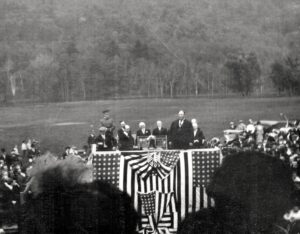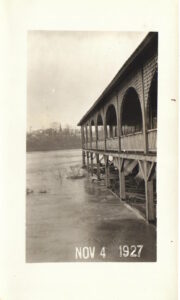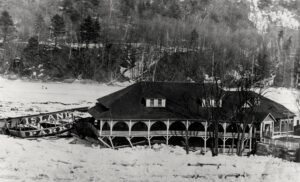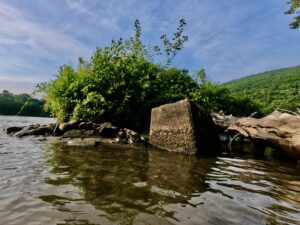Island Park
Brattleboro's PlaygroundIn the Connecticut River there used to be a pretty bigThe island between Brattleboro and Hinsdale. In the 1800’s it wasHinsdale was over 22 acres.
-
1862
In 1862 a Connecticut Valley flood devastated the island. The tollhouse was washed away, as was the farmhouse, and when the waters subsided about eight sandy acres of land remained. By 1874 the largest chicken farm in the area had established itself on the island with over 2000 hens and chickens. In the 1880’s Brattleboro and Hinsdale joined together, bought the toll bridge company and made the bridge connection between the two towns free and open to the public.
-
1879
-
1800s
In the late 1800’s a brewery and saloon existed on the island and the island developed a sketchy reputation. In the early 1900’s Brattleboro and Hinsdale got into a disagreement about the brewery as Brattleboro had become a dry town, while Hinsdale was a licensed town that allowed the brewery to operate. The island officially belonged to Hinsdale so Fred Gale gained a license from Hinsdale and operated the brewery and saloon.
After a few years of court battles, Fred Gale lost his ability to operate the brewery and saloon. The land where the brewery and saloon were located was put up for auction and two Brattleboro businessmen, Michael Moran and George Fox bought the island property.
The Island Park Amusement Company was formed by the two owners. They were both progressive Brattleboro businessmen and were highly influenced by their wives to purchase the island property. Their wives were very involved in the Temperance Movement. Alcohol abuse, and the social and family ills that came with it, were under attack by local temperance societies. Mrs. Moran and Fox both wanted to change the reputation of the island and the tag line for the new amusement park was “the home of clean amusement”. The intent of the park was to provide Brattleboro citizens, and visiting tourists, the opportunity to bring their families to the park for entertainment that would not include alcohol.
-
1804
- In 1804, a private company built a toll bridge to connect Brattleboro and Hinsdale with the island. This opened up trade along an east/west corridor and benefited both communities. For many years the island was a major farm. For a time, there was a slaughterhouse on the island and a granite shed as well. The island proved to be pretty versatile.
-
1909
Vernon dam was constructed.
-
1911
In 1911 there were about 8,500 residents in Brattleboro. Island Park was an amusement center built on the island between Hinsdale and Brattleboro and visitors as far away as Boston came to Brattleboro to experience baseball games, horse and buggy rides up Mt. Wantastiquet, bowling, boating, motion pictures and dancing. Some baseball contests drew as many as 3,000 spectators. The park was located on the Brattleboro side of the island and was reached by an easy walk or ride across the bridge.
Island Park had a 1200 seat grandstand, a baseball field, a pavilion for dancing, movies and bowling, and a soda fountain and Ice cream parlor. It also had a boat launch and was open every day of the week during the summer. Vaudeville acts, orchestras, bands and movies played in the pavilion. Outside, professional and amateur baseball games took place in the summer and high school football games were played in the fall. Island Park’s first two years were its best. In 1911, the local baseball team, the Brattleboro Islanders, won the Connecticut Valley League pennant by defeating Keene 2 to 0 in the championship game played at Island Park. The park had controversies of its own. Vermont’s Blue Laws did not allow businesses to be open on Sundays and the serving of ice cream, and other sweets, in the pavilion was seen as inappropriate on the Sabbath. The New Hampshire location of the island allowed for leniency.
-
July 4, 1911
 July 4th 1911 Opening of the park. Notice the line of people that backs up to Main Street. They were in line to get a tour of the new park and/or a boat ride courtesy of the Bigelow Boat Company.
July 4th 1911 Opening of the park. Notice the line of people that backs up to Main Street. They were in line to get a tour of the new park and/or a boat ride courtesy of the Bigelow Boat Company. -
1912
In 1912, plans to build a large hotel next to Island Park were announced. This was a time when business was booming in Brattleboro. The cotton mill had just been built in the southeast end of town and many thought the town would continue to grow.
Unfortunately, the Vernon Dam was constructed in 1909, two years before Island Park opened. Everyone knew the island would be inundated during high water runoffs in the spring and each year the water level grew higher. The Pavilion and Grandstand were built on piers that lifted the buildings higher than any previous flood had risen, but it didn’t prove to be enough. The spring floods, coupled with the breaking ice, were too powerful for the island. Each year the Park was damaged and needed to be repaired.
-
President Taft at Island Park, 1912.

-
1918
Plans to build the hotel were dropped. By 1918, the original owners had died and the park was purchased by the power company that owned the Vernon dam. Boating, baseball, bowling, movies and vaudeville were eventually dropped, but the dance hall continued.
The island was used for other events as well. Two presidents, William Howard Taft and Theodore Roosevelt held campaign rallies on the island. Beauty pageant winners were featured and circuses often visited the island as well. The circus would arrive by train around 5:30 a.m., unload and set up on the island. By noon there would be a circus parade on Main Street, then there would be an afternoon performance and an evening performance and the circus would be gone by the next day.
-
1920
In 1920 a major ice flood came down the Connecticut River and the bridge connecting Brattleboro with the island was washed away. After a few failed attempts, it took about a year before a permanent replacement bridge was completed. This inability to reach the island during the busy summer season contributed to the decline of the amusement park.
-
November 4, 1927

-
1927 "Ice Out"

-
1927
In 1927 a major flood and subsequent “ice out” knocked down most of Island Park and more than half of the island was washed away. The power company demolished the remaining structures and Island Park ceased to exist. In 1936 the largest flood in Brattleboro history washed away what remained of the island and today we only have the strip of land that joins the two bridges to remind us of Island Park.
We’d like to thank, and acknowledge the research of, local historians Dana Sprague and Dick Mitchell. Much of the information for This Week in Brattleboro History comes from their research about the island.
-
2020
A concrete stanchion marks the former site of Island Park.



 July 4th 1911 Opening of the park. Notice the line of people that backs up to Main Street. They were in line to get a tour of the new park and/or a boat ride courtesy of the Bigelow Boat Company.
July 4th 1911 Opening of the park. Notice the line of people that backs up to Main Street. They were in line to get a tour of the new park and/or a boat ride courtesy of the Bigelow Boat Company.


